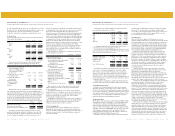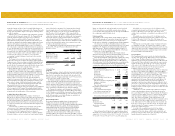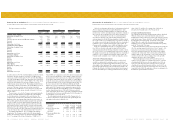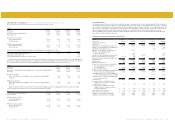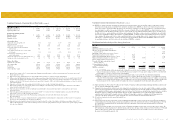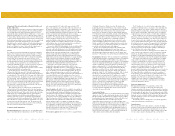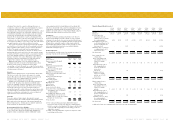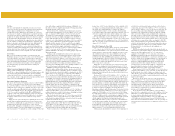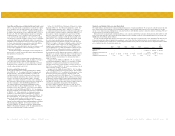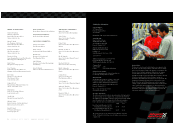Advance Auto Parts 2001 Annual Report Download - page 27
Download and view the complete annual report
Please find page 27 of the 2001 Advance Auto Parts annual report below. You can navigate through the pages in the report by either clicking on the pages listed below, or by using the keyword search tool below to find specific information within the annual report.
48 ADVANCE AUTO PARTS ANNUAL REPORT 2001 ADVANCE AUTO PARTS ANNUAL REPORT 2001 49
Liquidity and Capital Resources
At December 29, 2001, we had outstanding indebtedness consisting of
$95.4 million of senior discount debentures, $355.4 million of senior
subordinated notes, borrowings of $495.0 million under our senior
credit facility, and $10.0 million of indebtedness under the McDuffie
County Development Authority Taxable Industrial Bonds.
In connection with the Discount acquisition, we entered into the
senior credit facility and issued $200.0 million in face amount of our
senior subordinated notes. Upon consummation of the Discount
acquisition, we used $485 million of borrowings under the new senior
credit facility and net proceeds of $185.6 million from the sale of the
senior subordinated notes to (1) fund the cash portion of the
consideration paid to the Discount shareholders and in-the-money
option holders, (2) repay $204.7 million in borrowings under
Discount’s credit facility (including repayment premiums of $5.8
million), (3) purchase Discount’s Gallman distribution facility from the
lessor for $34.1 million, (4) repay $270.3 million of borrowings under
our prior credit facility, and (5) pay approximately $30 million in
related transaction fees and expenses. At February 28, 2002, we had
approximately $17.4 million in letters of credit outstanding and had no
borrowings under the revolving credit facility, resulting in available
borrowings of $142.6 million under the revolving credit facility.
In 2001, net cash provided by operating activities was $103.5
million. This amount consisted of $11.4 million in net income,
depreciation and amortization of $71.2 million, amortization of
deferred debt issuance costs and bond discount of $14.6 million,
impairment of assets held for sale of $12.3 million, amortization of
stock option compensation of $11.7 million and an increase of $17.7
million of net working capital and other operating activities. Net cash
used for investing activities was $451.0 million and was comprised
primarily of capital expenditures of $63.7 million and cash
consideration of $390.0 million in the Discount and Carport mergers.
Net cash provided by financing activities was $347.6 million and was
comprised primarily of net borrowings and issuance of equity.
In 2000, net cash provided by operating activities was $104.0
million. This amount consisted of $19.6 million in net income,
depreciation and amortization of $66.8 million, amortization of
deferred debt issuance costs and bond discount of $13.1 million and a
decrease of $4.5 million in net working capital and other operating
activities. Net cash used for investing activities was $65.0 million and
was comprised primarily of capital expenditures. Net cash used in
financing activities was $43.6 million and was comprised primarily of
net repayments of long-term debts.
In 1999, net cash used in operating activities was $21.0 million.
This amount consisted of a $25.3 million net loss, offset by
depreciation and amortization of $58.1 million, amortization of
deferred debt issuance costs and bond discount of $12.2 million, and an
increase of $66.0 million in net working capital and other operating
activities. Net cash used for investing activities was $113.8 million and
was comprised primarily of capital expenditures of $105.0 million and
cash consideration of $13.0 million in the Western merger. Net cash
provided by financing activities was $121.3 million and was comprised
primarily of net borrowings.
Our primary capital requirements have been the funding of our
continued store expansion program, store relocations and remodels,
inventory requirements, the construction and upgrading of distribution
centers, the development and implementation of proprietary
information systems, the Discount acquisition, the Western merger and
the Carport acquisition. We have financed our growth through a
combination of internally generated funds, borrowings under the credit
facility and issuances of equity.
Our new stores, if leased, require capital expenditures of
approximately $120,000 per store and an inventory investment of
approximately $150,000 per store, net of vendor payables. A portion of
the inventory investment is held at a distribution facility. Pre-opening
expenses, consisting primarily of store set-up costs and training of new
store employees, average approximately $25,000 per store and are
expensed when incurred.
Our future capital requirements will depend on the number of new
stores we open and the timing of those openings within a given year.
We opened 140 new stores during 2000 and 80 new stores during 2001
(excluding stores acquired in the Carport and Discount acquisitions). In
addition, we anticipate adding approximately 100 to 125 new stores
through new store openings and selective acquisitions during 2002. Our
capital expenditures were approximately $63.7 million in 2001
(excluding the Carport and Discount acquisitions). These amounts
related to the new store openings, the upgrade of our information
systems (including our new point-of-sale and electronic parts catalog
system) and remodels and relocations of existing stores. In 2002, we
anticipate that our capital expenditures will be approximately $105
million, of which approximately $34 million will involve conversion
and other integration related capital expenditures associated with the
Discount acquisition.
Historically, we have negotiated extended payment terms from
suppliers that help finance inventory growth, and we believe that we
will be able to continue financing much of our inventory growth
through such extended payment terms. We anticipate that inventory
levels will continue to increase primarily as a result of new store
openings.
As part of normal operations, we continually monitor store
performance, which results in our closing certain store locations that do
not meet profitability objectives. In 2001, we closed three stores as part
of 2000 restructuring activities and decided to close or relocate 39
additional stores that did not meet profitability objectives, 27 of which
were closed or relocated at December 29, 2001. In addition, as part of
our ongoing review of our store performance and our focus on
increasing the productivity of our entire store base, we anticipate
closing approximately 25 additional Advance Auto Parts stores in 2002.
As a result of the Carport acquisition, we closed 21 acquired stores not
expected to meet profitability objectives. As part of our integration of
Discount, we expect to close 108 and 27 Discount and Advance stores,
respectively, that are in overlapping markets, as well as Discount stores
that do not meet profitability objectives. In addition, we made the
decision to close a duplicative distribution facility located in
Jeffersonville, Ohio.
The Western merger, Carport acquisition and Discount acquisition
also resulted in restructuring reserves recorded in purchase accounting
for the closure of certain stores, severance and relocation costs and
other facility exit costs. In addition, we assumed certain restructuring
and deferred compensation liabilities previously recorded by Western
and Discount. At December 29, 2001, these reserves had a remaining
balance of $23.6 million. At December 29, 2001, the total liability for
the assumed restructuring and deferred compensation plans was $2.1
million and $4.3 million, respectively, of which $1.2 million and $2.3
million, respectively, is recorded as a current liability. The classification
for deferred compensation is determined by payment terms elected by
plan participants, primarily former Western employees, which can be
changed upon 12 months’ notice.
We expect that funds provided from operations and available
borrowings of approximately $142.6 million under our revolving credit
facility at February 28, 2002, will provide sufficient funds to operate
our business, make expected capital expenditures of approximately
$105 million in 2002, finance our restructuring activities, redeem our
industrial revenue bonds in November 2002 in an aggregate principal
amount of $10 million and fund future debt service on our senior
subordinated notes, our senior discount debentures and our senior credit
facility over the next 12 months.
Long Term Debt
Senior Credit Facility. In connection with the Discount acquisition, we
entered into a new senior credit facility consisting of (1) a $180 million
tranche A term loan facility due 2006 and a $305 million tranche B
term loan facility due 2007 and (2) a $160 million revolving credit
facility (including a letter of credit subfacility). The senior credit
facility is jointly and severally guaranteed by all of our domestic
subsidiaries (including Discount and its subsidiaries) and is secured by
substantially all of our assets and the assets of our existing and future
domestic subsidiaries (including Discount and its subsidiaries).
The tranche A term loan facility matures on November 30, 2006 and
provides for amortization of $11.0 million at the end of the first year,
semi-annual amortization aggregating $27.4 million in year two, $43.6
million in year three and $49.0 million in each of years four and five.
The tranche B term loan facility matures on November 30, 2007 and
amortizes in semi-annual installments of $2.5 million for five years
commencing on November 30, 2002, with a final payment of $280.0
million due in year six. The revolving credit facility matures on
November 30, 2006. The interest rate on the tranche A term loan
facility and the revolving credit facility is based, at our option, on either
an adjusted LIBOR rate, plus a margin, or an alternate base rate, plus a
margin. From July 14, 2002, the interest rates under the tranche A term
loan facility and the revolving credit facility will be subject to
adjustment according to a pricing grid based upon our leverage ratio (as
defined in the senior credit facility). The initial margins are 3.50% and
2.50% for the adjusted LIBOR rate and alternate base rate borrowings,
respectively, and can step down incrementally to 2.25% and 1.25%,
respectively, if our leverage ratio is less than 2.00 to 1.00. The interest
rate on the tranche B term loan facility is based, at our option, on either
an adjusted LIBOR rate with a floor of 3.00% plus 4.00% per annum
or an alternate base rate plus 3.00% per annum. A commitment fee of
0.50% per annum will be charged on the unused portion of the
revolving credit facility, payable quarterly in arrears.
Borrowings under the senior credit facility are required to be
prepaid, subject to certain exceptions, in certain circumstances.
The senior credit facility contains covenants restricting our ability
and the ability of our subsidiaries to, among others things, (i) pay cash
dividends on any class of capital stock or make any payment to
purchase, redeem, retire, acquire, cancel or terminate capital stock, (ii)
prepay, redeem, retire, acquire, cancel or terminate debt, (iii) incur liens
or engage in sale-leaseback transactions, (iv) make loans, investments,
advances or guarantees, (v) incur additional debt (including hedging
arrangements), (vi) make capital expenditures, (vii) engage in mergers,
acquisitions and asset sales, (viii) engage in transactions with affiliates,
(ix) enter into any agreement which restricts the ability to create liens
on property or assets or the ability of subsidiaries to pay dividends or
make payments on advances or loans to subsidiaries, (x) change the
nature of the business conducted by us and our subsidiaries, (xi) change
our passive holding company status and (xii) amend existing debt
agreements or our certificate of incorporation, by-laws or other
organizational documents. We are also required to comply with
financial covenants in the credit facility with respect to (a) limits on
annual aggregate capital expenditures, (b) a maximum leverage ratio,
(c) a minimum interest coverage ratio and (d) a ratio of current assets
to funded senior debt. We were in compliance with the above covenants
under the senior credit facility at December 29, 2001.
Senior Subordinated Notes. On October 31, 2001, in connection with
the Discount acquisition, we sold an additional $200.0 million in senior
subordinated notes at an issue price of 92.802%, yielding gross
proceeds of approximately $185.6 million, the accreted value of which
was $185.9 million at December 29, 2001. These senior subordinated
notes were an addition to the $200.0 million face amount of existing
senior subordinated notes that we issued in connection with the
recapitalization in April 1998, of which $169.5 million was outstanding
at December 29, 2001. All of the notes mature on April 15, 2008 and
bear interest at 10.25%, payable semi-annually on April 15 and October
15. The notes are fully and unconditionally guaranteed on an unsecured
senior subordinated basis by each of our existing and future restricted
subsidiaries that guarantees any indebtedness of us or any restricted
subsidiary. The notes are redeemable at our option, in whole or in part,
at any time on or after April 15, 2003, in cash at certain redemption
prices plus accrued and unpaid interest and liquidating damages, if any,
at the redemption date. The indentures governing the notes also contain
certain covenants that limit, among other things, our and our
subsidiaries’ ability to incur additional indebtedness and issue preferred
stock, pay dividends or make certain other distributions, make certain
investments, repurchase stock and certain indebtedness, create or incur
liens, engage in transactions with affiliates, enter into new businesses,
sell stock of restricted subsidiaries, redeem subordinated debt, sell
assets, enter into any agreements that restrict dividends from restricted
subsidiaries and enter into certain mergers or consolidations.



